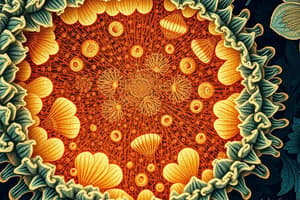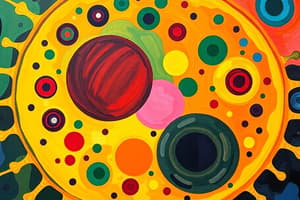Podcast
Questions and Answers
What is the approximate thickness of the plasma membrane in animal cells?
What is the approximate thickness of the plasma membrane in animal cells?
- 75-100 nm (correct)
- 30-40 nm
- 15 A
- 45 A
According to the fluid mosaic model, how are the phospholipids arranged in the plasma membrane?
According to the fluid mosaic model, how are the phospholipids arranged in the plasma membrane?
- Hydrophilic polar heads are arranged in the middle and hydrophobic non-polar tails point inwards.
- Hydrophilic polar heads are evenly distributed throughout the membrane.
- Hydrophilic polar heads are towards the inner surface and hydrophobic non-polar tails point outwards.
- Hydrophilic polar heads are towards the outer surface and hydrophobic non-polar tails point inwards. (correct)
Which type of proteins in the plasma membrane are either embedded in the lipid layer or superficially attached?
Which type of proteins in the plasma membrane are either embedded in the lipid layer or superficially attached?
- Cholesterol molecules
- Extrinsic (peripheral) proteins
- Integral (intrinsic) proteins (correct)
- Glycoproteins
What percentage of proteins make up the plasma membrane in animal cells?
What percentage of proteins make up the plasma membrane in animal cells?
What do carbohydrates form on the outer surface of the plasma membrane in animal cells?
What do carbohydrates form on the outer surface of the plasma membrane in animal cells?
What prevents some small molecules from crossing the membrane and keeps the membrane fluid and flexible?
What prevents some small molecules from crossing the membrane and keeps the membrane fluid and flexible?
What characteristic of phospholipids helps maintain fluidity in the cell membrane at lower temperatures?
What characteristic of phospholipids helps maintain fluidity in the cell membrane at lower temperatures?
What functions as a buffer, preventing lower temperatures from inhibiting fluidity and preventing higher temperatures from increasing fluidity too much?
What functions as a buffer, preventing lower temperatures from inhibiting fluidity and preventing higher temperatures from increasing fluidity too much?
What type of transport involves substance moving from its high concentration towards its lower concentration?
What type of transport involves substance moving from its high concentration towards its lower concentration?
In osmosis, where do solvent molecules migrate across a semi-permeable membrane?
In osmosis, where do solvent molecules migrate across a semi-permeable membrane?
Flashcards are hidden until you start studying
Study Notes
Plasma Membrane Structure and Function
- The plasma membrane in animal cells has an approximate thickness of 5-10 nanometers.
- According to the fluid mosaic model, phospholipids in the plasma membrane are arranged in a bilayer, with their hydrophobic tails facing inward and hydrophilic heads facing outward.
- Integral proteins are embedded in the lipid layer, while peripheral proteins are superficially attached to the plasma membrane.
- Proteins make up approximately 50% of the plasma membrane in animal cells.
Carbohydrates and Fluidity
- Carbohydrates form a glycocalyx on the outer surface of the plasma membrane in animal cells.
- Unsaturation of phospholipid tails prevents some small molecules from crossing the membrane and keeps the membrane fluid and flexible.
- The unsaturated tails of phospholipids help maintain fluidity in the cell membrane at lower temperatures by allowing them to remain flexible and not solidify.
Cholesterol and Temperature Regulation
- Cholesterol functions as a buffer, preventing lower temperatures from inhibiting fluidity and preventing higher temperatures from increasing fluidity too much.
Transport and Osmosis
- Passive transport involves substances moving from their high concentration towards their lower concentration.
- In osmosis, solvent molecules migrate across a semi-permeable membrane from an area of high concentration to an area of low concentration.
Studying That Suits You
Use AI to generate personalized quizzes and flashcards to suit your learning preferences.




